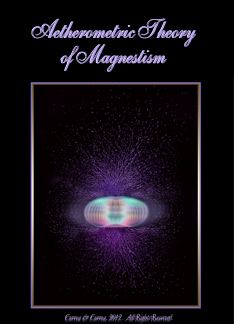![Akronos logo]](/images/akronos_wheel.jpg)
|
Akronos Publishing Concord, ON, Canada www.aetherometry.com |
![Akronos logo]](/images/akronos_wheel.jpg)
|
Akronos Publishing Concord, ON, Canada www.aetherometry.com |

Aetherometric Theory of Magnetism
by Correa, Paulo N. & Correa, Alexandra N.
Published in January 2013. 69 pages.
Aetherometric Theory of Synchronicity, Vol. 3
Monograph AS3-III.7
Price: (ISFA only) US $20
This monograph is available exclusively to ISFA members, or by special arrangement.
|
ABSTRACT
The aetherometric theory of magnetism proves that there is no independent physical reality to the notions of a "magnetic energy" or magnetic monopoles. There is only electric energy associated with massfree and massbound charges, and in the case of the latter, this encompasses kinetic energy and mass-energy. All forms of electric energy deploy constitutive magnetic waves and diamagnetic fields, but the energy associated with magnetism is electric, and not magnetic. Similarly, all the magnetic frequency functions that we have identified and analyzed are found to be subtypes of electric (nonquantum or Teslan) frequency functions. In this context, we systematize the fundamental rules and formalism of the aetherometric treatment of energy, power, and the quantum and non-quantum frequency functions of massbound and massfree charges. Even though we demonstrate under what conditions in vacuo H and B have the same value - μ = B/(2π H) = μ0AToS ε0AToS c2 = μ0 ε0AToS c2/2 = 1- H is also shown to be a measure of the linear density of superimposed wavelines, and always associated with the geometric mean velocity of a flux, be it kinetic or merely "kinemassic"; whereas B is shown to be a measure of the linear density of the radial lines of magnetic waves, and to depend on the characteristic magnetic waves of a charge. In other words, the only truly magnetic field functions are the B-type functions associated with the cyclotron frequency - the frequency of magnetic waves. The H-type functions are not truly magnetic, but 'electromagnetic' geometric-mean functions of the superimposition of magnetic and electric waves. The two measures of so-called "magnetic fields" only coincide when one is dealing with massfree charges in vacuo, but they are distinct from the start when dealing with massbound charges. We also suggest that the correct measure of the linear density of magnetic wavelines in material media is B/2π, not B. The analytical power of the aetherometric technique is underlined by a series of fundamental and practical determinations. Amongst the fundamental examples we highlight the linear density of "electromagnetic" wavelines with speed v = c in the electron mass-energy given by its "intrinsic magnetic field" function H HMBδe = λq-1 = 2.145946*107 wavelines m-1and the exact determination of the B (true) magnetic field of the electron mass-energy BMBδe = 2π Fcycloe/Wk = rh-1 = η/rq = 2π η HMBδe = 1.5873*1010 rad m-1 =∫=On the practical side, we demonstrate how only the determination of the magnetic field BMBδe in real gauss or tesla matches the detection at the gaussmeter of the angular velocity of the same magnetic field in read gauss or tesla; for the electron mass-energy: BMBδe = rh-1 = 2π η HMBδe = 2.298*105 real tesla =∫∫= ωcycloe = 2π Fcycloe =The gaussmeter does not exactly measure (real) gauss, or the reciprocal of radial length, but in fact it measures angular 'velocity' or frequency (read gauss), which we have noted is calibrated for the electron magnetic field wave. Indeed, the same numerical value of a cyclotron frequency can result in very different values of field B, depending upon whether the field B in question arises from a flux of massbound versus massfree charges. Lastly, we provide exact equivalences for the correct fundamental magnetic field units of the CGS and SI systems: 1 real gauss = 1 dyne rad/esu*c = 10-5 newton rad/esu *c =∫= 6.90652 rad m-1and determine the angular cyclotron frequency of a magnetic field of 1 gauss for massfree charge with speed Wv = c: ωcycloMFg = c B = 2.0705*109 rad sec-1 = 1 dyne rad/esu |